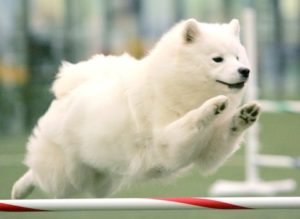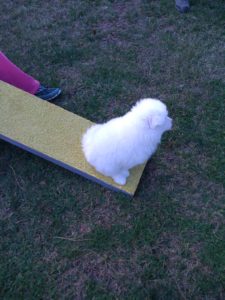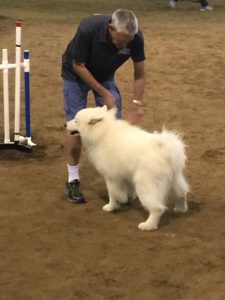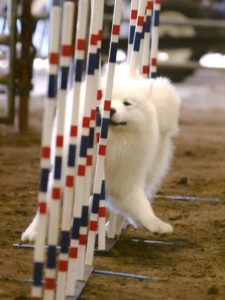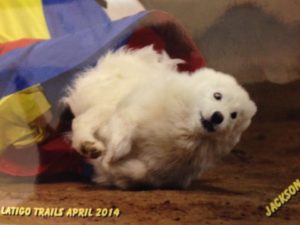Obedience and Agility
Obedience
Many of the traits attributed to Samoyeds make them ideal candidates for obedience training. Their willingness to please (rewarded of course by a treat) and their ability to learn quickly make them great obedience prospects.
So why isn’t the word “Samoyed” synonymous with the word “obedience”? The same traits that make them an ideal candidate also make them at times a challenge to train. Many Samoyeds become bored repeating the same actions over and over. They seem to look at us and say ” stupid human, I already did that, how many more times do you expect me to do the same thing?” At times this leads to them adding their own variations to the routine. Many Samoyeds have been presented the “class clown” award at graduation from training classes.
Another important difference between Samoyeds and many of the “obedience breeds” is their reaction to corrections. Many potential obedience prospects have been ruined because they were expected to perform in an untypical Samoyed fashion and corrected unfairly for not.

Overall, Samoyeds can be trained to compete with the best of obedience dogs. Patience, generous praise (after all, they are doing this to please you) and understanding of subtle differences in training techniques will bring out their best. A sense of humor on your part is also very important. This is one breed that will eventually pull some antics in the obedience ring, which will keep you humble!
All you have to lose is a few hours a week in exchange for a life-long stronger bond with your four-legged friend!
-By Genevieve Deltieure, SCA Obedience Coordinator
Agility
Have you ever thought “My dogs would probably enjoy agility”? Well, stop thinking and jump into the most fun game you and your Samoyed can play as a team – agility. Yes, there are other performance events such as lure coursing, barn hunting, and obedience but once you and your Sammy experience the thrill and satisfaction of running as a team, nothing will come close!
Why do agility with your dog? Connection. Becoming an agility team with your Sammy will foster a deep, trusting connection with your Samoyed like nothing else. You will grow together, and that’s when the bond we all cherish so much really crystallizes. Agility will also help keep you and your Sammy sharp, both mentally and physically.
Two beautiful things about agility:
- Agility is one of the most objective venues in which to compete with your dog. There’s no silly politics here. You’ll learn how to improve and how to work with your dog’s strengths.
- You can make every agility day a good day by learning something and finding something to celebrate. Something good happens for someone, at every trial or lesson. It’s not hard to find if you look. And you can set yourself up for wins with every run, whether you “Q” (qualify) or not.
A little history: Agility started in the United Kingdom in the late 1970s as a demonstration event during Crufts. As more and more people requested to see the special demonstration, they were inspired to try it at home with their own dogs. Thus, agility was born. It was formally organized in the UK in the early 1990s and the first AKC trials were run in the United States in the mid-1990s. The Samoyed Club of America was the very first specialty breed club to offer agility trials at their Nationals! We recognized early on that we have a breed that is truly born for this sport.
The history of our breed shows that Samoyeds are born to work with people in many capacities. This strong dog-human bonding bodes well for the working relationship required for agility. Most observers are struck by not only the beauty of our dogs, but by our dogs’ strong desire to work with us. What is even more remarkable is seeing how much fun they have doing it! Our most successful human competitors not only enjoy a strong working relationship with their dogs, they provide hours and hours of fun and challenges for their canine teammates. One of the more unique features to working with our Northern breed: they are often much smarter than we give them credit for and they do not care for endless repetition. This is probably the most challenging aspect of Samoyed agility: to provide a dynamic, systematic, and fun working environment. They keep us on our toes!
So, how do you get started? Light “foundation” work is the key to beginning your agility dog. Simple, fast, and fun exercises that they enjoy and are rewarded for (often!) are a great start. Learning to go through jump standards (no bars), follow your hand, move across unstable surfaces are all part of building a working relationship. Focusing on your agility teammate for just short periods of time and rewarding strongly will prove an excellent start to a working relationship. In time, longer training sessions with more complicated tasks can be introduced. There are many outstanding books, CDs, and online courses available (Susan Garrett is one of the best) so that you can get started in your own back yard.
From foundation work, many people choose to go to local classes taught by local instructor/competitors. There, agility teams learn how to correctly perform specific agility obstacles and face the distraction of other dogs nearby. This is usually an excellent way to begin, but do not be fooled! Classes do not necessarily “train” you and your teammate; they usually just expose you to the various obstacles and care must be taken to not assume that your teammate understands correct obstacle performance based on once-a-week exposure. According to many dog behaviorists, your canine partner must perform a sequence/obstacle/technique at least 100 times correctly and consistently to “get it” (in other words, considered “trained”). So, homework is absolutely critical to ensure that your teammate continues an upward learning trajectory. That does not mean, though, that you must have a 100’ X 100’ area dedicated to agility equipment in your backyard. You can train many things in your own living room or patio. All you need is a little space, treats or toys, good, solid footing, a good imagination, and away you go!
Once your Sammy has an idea of correct performance of the obstacles, it is time to work on handling skills for the human part of the team. In class, you should learn basic handling techniques that allow you to “cut corners” while still guiding your Sammy to the next correct obstacle. Front, blind, back crosses are all commonly used tools that allow you (the partner that “knows” the course) to be in the best possible position in time to give timely information to your Sammy. Interestingly, this is the most difficult part of training! When an error is made on course, it is usually the human that is in the wrong place or too late with information, and that fouls up our dog! Our dogs are watching our motion, speed, foot placement, shoulders, and even our eyes to determine which direction to go. Notice that the use of our voice and vocal commands was not mentioned! Our dogs do listen to us, but it is way down the priority list (some would say not there at all, but that mostly is not true). Vocal commands are best used in discriminations (tunnel vs. dogwalk or A-frame vs. table). Vocals are best for praise – lots of praise! So……even if you are physically challenged, physical signals will work even at a distance whereas vocal commands are far more ambiguous. Which brings up a quick point: there are plenty of 80+ year olds running their dogs in agility! Age is just a number. Many people find so much motivation and support in agility that, despite starting agility in their retirement years, they have so much fun that they don’t think twice about that “age thing”!
Now that you and your Sammy have formed a working team, you may be tempted to enter an agility trial. You will compete at a jump height based on your dog’s height at the withers. Most Samoyeds compete in the 20” class (they are 22” or less at the withers). Titles are earned in most venues when 3 qualifying “legs” are achieved. Novice, Open, Excellent, and Masters are class levels in AKC. Titles can be earned in each level and the grand-daddy of them all, the Master Agility Champion (MACH) is so prestigious that AKC allows it to precede the dog’s registered name. To date, there have been dozens of MACH titles earned by Samoyeds, with several earning MACH2, MACH3, MACH4 and MACH5! There have been 4 Samoyeds that have appeared and placed in the AKC Agility Invitational finals! Many teams choose to compete in USDAA (United States Dog Agility Association) or NADAC, which offer more “games”. In USDAA, the most prestigious title is the ADCH (Agility Dog Champion), and so far, only one Samoyed has earned this very difficult title.
A few thoughts on the mental part of the game:
- Our dogs always want to please us. Distractions or behaviors can sometimes get in the way of that aim, but the intent to please is always there.
- Focus on what you can control or influence, and let go of anything else. It’s wasted energy. Luck, good and bad, does play a part in agility, and that’s part of the game. There is generally going to be another shot for those of us who want it enough.
- Keep your thoughts on what you want to have happen. Hang with positive people play games like 카지노순위, and tune out any negativity as much as possible.
- Enjoy each run as if it might be your last.
- Celebrate the dog you have!
- Bask in the fun, especially when you do well. Don’t be shy about being happy. Your Sammy will revel in that.
So……come join the FUN, EXCITEMENT, and sheer JOY of agility. You’ll meet new friends and form the closest bond possible with your Sammy. You will discover the immense satisfaction of working with one of the most beautiful dogs in the world and learn how to celebrate even the smallest of achievements with your wonderful teammate and friends! In short, you will become more, and your Sammy will become more – what could be better? And, you’ll RUN WITH A SMILE!!
-By Sheri Hudson and Ginger Jenks

